
Black Tape on the South Porch Wall
by: Leonard Oliver Nasman
copyright 2005
(NOTE: colored underlined words are hyperlinks. Click on them for more info.)
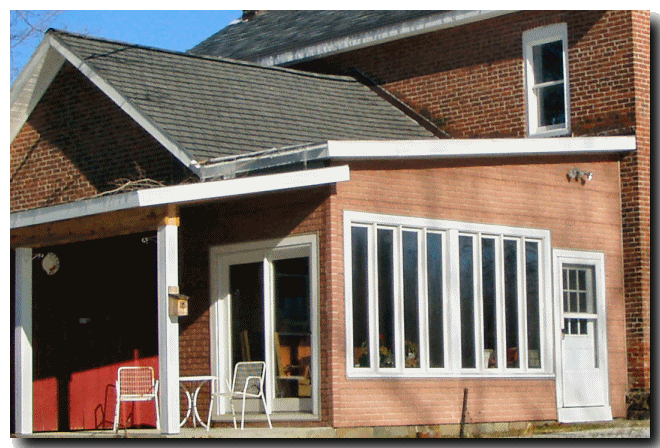
It’s December 20, 2005. The day before the Winter Solstice. The sky over Woodhaven is an arctic blue and the temperature is 16 degrees.
The Jet Stream has been pushing cold northern air into Ohio for several weeks now. According to the local weather guys this has been one of the
coldest Decembers on record. 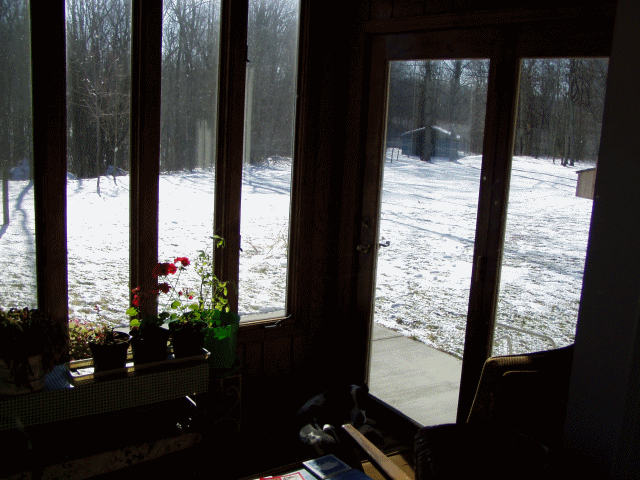
In spite of the cold, the temperature on the unheated south porch at 10 AM is 60 degrees. This is because of a combination of luck and planning.
Right now, it is very comfortable sitting in my rocking chair watching tiny diamonds sparkling in the inch or so of light snow that fell
last night. 
With the sun streaming into the porch it seems much warmer. A couple of geraniums, rescued before the first frost, brighten up the place with a splash of red.
When we first acquired Woodhaven in the fall of 1987, the south porch was a wreck.
 The old roof was in need of patching, and the porch floor had so many holes it was actually dangerous to step on. Also, there was an enclosed woodshed
on the west side of the porch that cut off most of the view.
The old roof was in need of patching, and the porch floor had so many holes it was actually dangerous to step on. Also, there was an enclosed woodshed
on the west side of the porch that cut off most of the view.
My solution was to switch the slope of the roof and tuck it as close as possible under the upstairs window. I made the porch floor closer to ground level to get the porch ceiling as high as possible. A row of tall windows was installed on the south wall, and a glass door/window was installed on the west wall. To cover the original sandstone foundation blocks supporting the house, we added a poured concrete step all around the interior of the porch. The result is that there is about seven cubic yards of concrete in the south porch. This concrete acts as a thermal mass that moderates the porch temperature.
I knew all along that the south facing windows would provide an extended season for using the porch. However, I had no idea just how good it would be.
It turns out that at exactly noon on the shortest day of the year, the sun shines fairly high on the inside wall of the porch. I have marked the edge of the shadow at the point the shadow makes at noon on December 21 with a piece of black tape. A little after 10 AM the shadow of the sun cast by the windows creeps toward my marker.
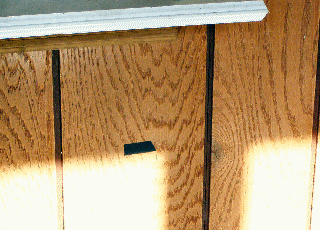
I watch carefully to see if the mark I made over ten years ago will still mark the sun position at the appointed time. Sure enough, at the appointed time, the shadow hits the mark. You have to watch close, because the shadow moves surprisingly fast.
At noon six months later, the sun barely casts a shadow on the porch floor under the windows and the porch is not heated by the summer sun the way it is in the winter. It turns out that this is perfect for a passive solar heated room.
Why does this shadow wander so predictably back and forth across the room? And why on December 21 does the sun stand still in it’s track, reverse course, and head back south? What is this thing called the Winter Solstice anyway. Well, here is my warped explanation of the situation.
Contrary to common belief held by religious leaders hundreds of years ago, the earth travels around the sun. The earth is also spinning around its axis as it travels around the sun. The earth follows a path that is nearly, but not exactly, a circle. If you could look at an edge view of the path of the earth, you could see that the axis of the earth is not perpendicular to the plane of the path it is following, but the axis is tilted a little more than 23 degrees.
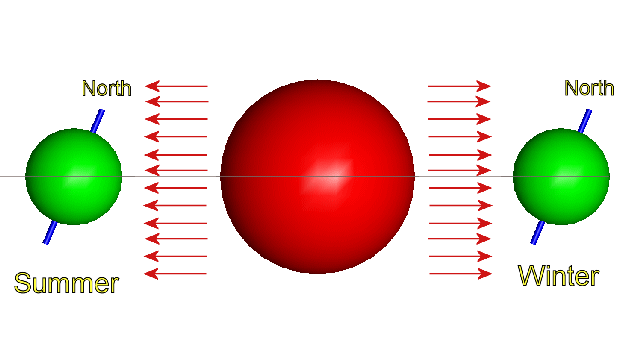
The figure illustrates that in summer more sunlight hits the north pole than the south pole, but in the winter, when the earth is half way along its annual trip around the sun, more light hits the south pole than the north pole.
Actually, the figure is nowhere close to showing the relative size of things. If the earth was drawn one inch in diameter, you would have to place it 1/4 of a mile to the left for the summer position, and another 1/4 of a mile to the right for the winter position. Also if the earth is drawn one inch in diameter, the sun would have to be drawn 12 feet in diameter to be drawn at the same scale. But, I digress...
Since the sun is so big compared to the earth, it seems like the light rays from the sun are parallel (as opposed to the rays of light coming from a small source, such as a candle). Anyway, in the winter, the sun gets farther into the south porch than in the summer.
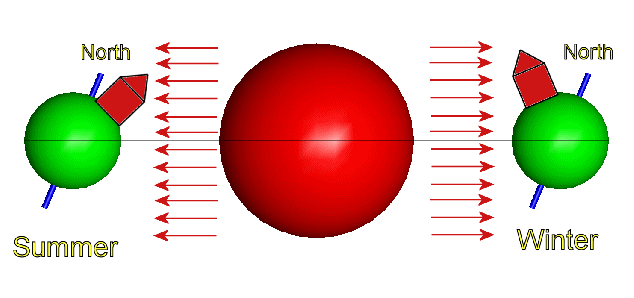
Since the earth is also rotating around its axis, the angle the sun makes as it comes through the windows constantly changes from sunrise to sunset. If you want to make a mark on the wall that predicts where a shadow will be, you have to know both the time of day and the time of year.
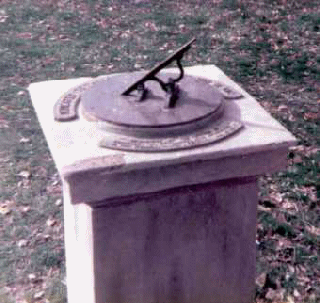
In the old days, it was popular to create sundials that showed the progress of the days and seasons. Some of these were the basic garden variety that most folks have seen.
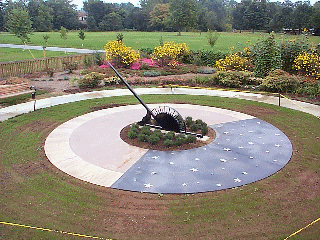
Some sundials are very large.
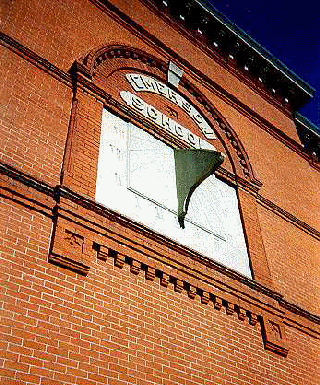
Some are built into the sides of buildings.
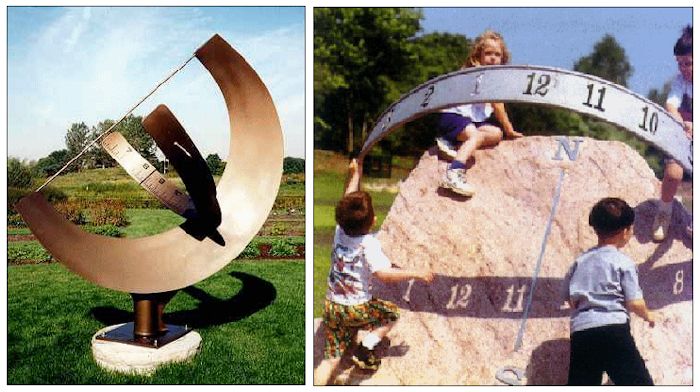
Others take on a variety of forms.
If you want to build your own sundial, this might be a good place to start < https://www.wikihow.com/Make-a-Sundial>.
Earlier, I mentioned that I placed the black tape on the wall at noon. I used my digital wrist watch to determine when noon was. However, this is
(at Woodhaven) eastern standard time. If you are designing a sundial, you have to go back to the old-fashioned solar
noon. 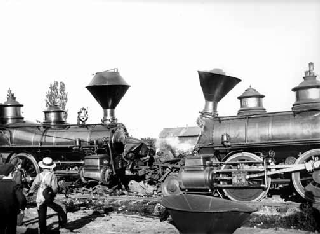
Did you know that when the Woodhaven house was built (around 1836) there were no time zones in use? In those days each town set its clocks to local (or solar) noon. Woodhaven is on the western side of the eastern time zone. Solar noon at Woodhaven is different from solar noon in New York City, even though both are in the same time zone. So who decided that everyone from New York to western Ohio should observe noon at the same time?
It turns out that the creation of time zones
was partly an effort to reduce the number of train wrecks. When it was noon at a different time at every town along the rail line, it was hard to
schedule trains running on the same tracks in a way that would prevent them from trying to occupy the same part of the track at the same time. As travel
increased, a standard time keeping method was needed to
reduce confusion. So, the powers that be decided to draw lines on the map that divided the country into different time zones. You might expect that these lines
would run straight north and south, but they jump all over the place to try and accommodate populations that have a need to be on similar
schedules. 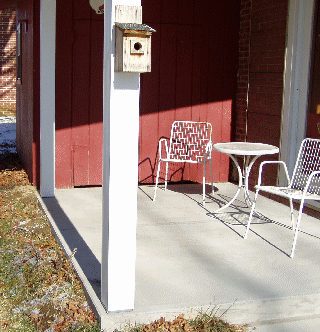
I wish I knew more about how the folks who built the Woodhaven house decided to align the walls. As far as I can tell, they placed the house very close to facing directly east. If they aligned the house exactly to face east, and if my patio is properly aligned with the house, I could determine solar noon by observing the shadow of the patio post with the patio slab.
In the old days, some people spent a lot of time observing changing sun shadows, the position of the sun and moon as the seasons passed, and they created remarkable devices for recording and preserving these observations.
I have recently been
reading in The Discoverers,
by Daniel Boorstin, how guys like Copernicus
and Galileo were persecuted by the religious leaders of
the day for relying more on their scientific observations than church doctrine. Church doctrine held that the sun revolved around the earth. Anyone who dared
to claim otherwise was in trouble. Nothing seems to have changed much in the last 500 years or so. It seems that a lot of people would still prefer to believe
a particular religious dogma than information based on careful scientific observation, and they would like the schools to push their particular uninformed views
on students. 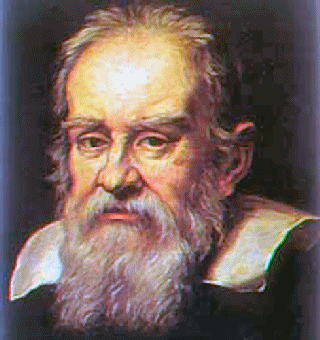
This is not to argue that scientists are infallible. Some of them hold on to their beliefs as tightly as the most narrow minded pope, priest, or preacher.
However, without careful observation of nature, mankind cannot advance in it’s understanding of nature. Without continuous refinement of observations and
understanding, we would have to resign ourselves to huddling under a rock shelter forever.
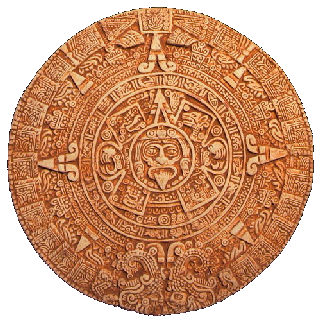
An amazing thing is how advanced ancient observers of the sky were, and that we have lost the knowledge of how and why these ancients were able to create the knowledge they possessed. We know, for example, that thousands of years ago Stonehenge was a fairly accurate astronomical observatory. We also know that the ancient natives from South America made calendars that covered thousands of years. Why would they do that?
Well, we now know that not only does the earth spin on its axis once a day and travels around the sun once a year, the earth’s axis wobbles.
This changes what stars appear in the sky at a particular time, namely during
the Vernal Equinox. The signs of the zodiac mark the different star groups
that appear at the Vernal Equinox throughout the ages.
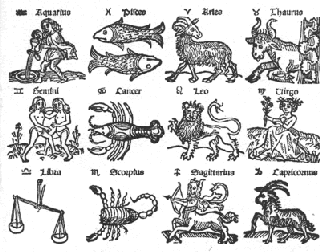
Did you ever wonder about the Age of Aquarius? This is the time when the constellation of Aquarius replaces another star cluster, Pisces, as a mile post marker for our earth’s tour. It takes around 25,000 years for the earth to complete this cycle. A problem for believers in astrology is that there is no universal agreement as to the edges of the different constellations. An amazing thing about the 25,000 year cycle of the constellations through the sky is that many ancient people knew about this long before some clerics tried to force folks to believe that the sun revolves around the earth.

Oh my, this is quite a lot to ponder as I sit in the Woodhaven porch, soak up the warm winter solar rays, and watch the sun’s shadow chase the black tape on the south porch wall.

